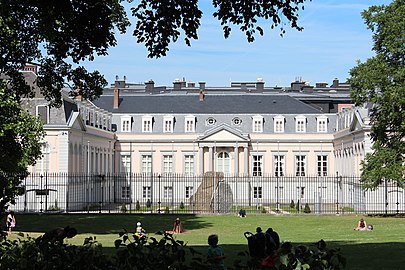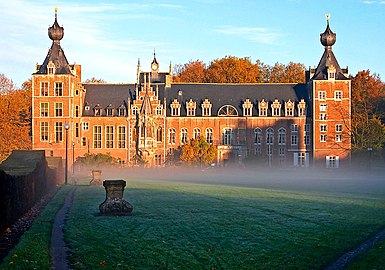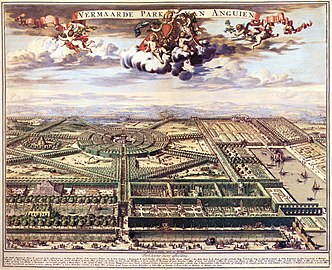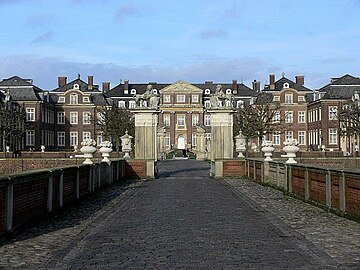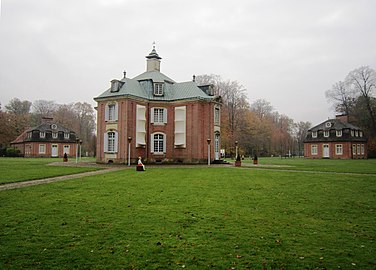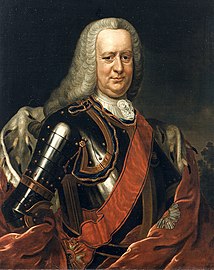House of Arenberg
| House of Arenberg | |
|---|---|
 Arms of the Dukes of Arenberg | |
| Founded | Middle Ages |
| Current head | Léopold, 13th Duke of Arenberg |
| Titles | |
| Style(s) | Serene Highness |
| Cadet branches | French ducal branch |
| Website | arenbergfoundation.eu |
The House of Arenberg is an aristocratic lineage that is constituted by three successive families that took their name from Arenberg, a small territory of the Holy Roman Empire in the Eifel region.[a] The inheritance of the House of Croÿ-Aarschot made the Arenbergs the wealthiest and most influential noble family of the Habsburg Netherlands. The family's Duchy of Arenberg was a Sovereign State until it was mediatized in 1810. As such, the Arenbergs belong to the small group of families that constitute the Hochadel (German for 'high nobility').
The current head of the house bears the title of Duke of Arenberg, while all other members are princes or princesses.[1] They all enjoy the style of Serene Highness.
In 1827, Prince Pierre d'Arenberg, third son of the 6th Duke of Arenberg, was granted the French noble title of duke by King Charles X and was made a hereditary peer of France. His descendants form a French cadet branch of the family, the head of which holds the French ducal title (duc d'Arenberg).
Lords of Arenberg
[edit]| Date[citation needed] | Name (birth–death) | Notes |
|---|---|---|
| 1032 | Ulrich, Viscount of Cologne | |
| 1061–1074 | Franco I. | |
| 1082–1135 | Arnold | |
| 1106–1135 | Franco II. | |
| 1136–1159 | Heinrich I. | |
| Gerhard | ||
| 1166/67–1197 | Heinrich II. de Arberg | |
| Eberhard (1200–1218) ∞ Aleidis of Molsberg | also Countess of Freusburg | |
| Heinrich III. (1220–1252) | ||
| Gerhard ∞ Mechthild von Holte | ||
| Johann (1267–1280) | married Johanna von Jülich, sold Viscounty of Cologne | |
| Mechthild | In 1299, married Count Engelbert II. von der Mark. |
Counts of Arenberg
[edit]| Date (reign) | Name | Notes |
|---|---|---|
| 1299–1328 | Count Engelbert II von der Mark | Count of La Marck and, by marriage, Lord of Arenburg |
| 1328–1387 | Count Eberhard von der Mark | Lord of Arenberg |
| 1387–1454 | Count Eberhard II von der Marck-Arenberg | Lord of Sedan, and Arenburg |
| 1454–1480 | Count Johann von der Marck-Arenberg | Lord of Sedan, & Arenburg |
| 1480–1496 | Count Eberhard III von der Marck-Arenberg | Lord of Arenburg; brother to Robert I de La Marck, Lord of Sedan and chatelain of Bouillon |
| 1496–???? | Count Robert I von der Marck-Arenberg | |
| ????–1536 | Count Robert II von der Marck-Arenberg | |
| 1536–1541 | Count Robert III von der Marck-Arenberg | After the extinction of the male line, his sister Margarethe (1541–1596) married in 1547 Count Jean de Ligne, Duke of Arenberg |
| 1541–1547 | Countess Margaretha von der Marck-Arenberg (1527–1599) | |
| 1568–1616 | Charles 2nd Princely Count of Arenberg | In 1576 elevated to Princely Count |
Princely Counts and later Dukes of Arenberg
[edit]
The marriage contract in 1547 between Margaret de la Marck, Countess of Arenberg, and Jean de Ligne-Barbançon stipulated that their offspring would abandon the name of Ligne (to which house they belonged) and adopt the name and arms of Arenberg. On 5 March 1576, Emperor Maximilian II raised Margaret and her son Charles to the rank of Princely Count (German: Gefürstete Graf). As such, the Arenbergs sat and voted on the bench of secular princes in the Imperial Diet. On 9 June 1644, Emperor Ferdinand III bestowed the title of Duke of Arenberg on Charles' grandsons, Philip-Francis and Charles-Eugene, as well as to all legitimate descendants of Charles and his brother Robert of Arenberg, prince of Barbançon.
Meanwhile, the marriage of Princely Count Charles to Anne de Croÿ, the sister and heiress of the last Croÿ Duke of Aarschot, had brought the Arenbergs a series of titles, as well as vast estates in the Habsburg Netherlands in 1612. The senior title was that of Duke of Aarschot. It had been created in 1534, it was the first (and until 1627 the only) ducal title in the Netherlands, and it carried the dignity of a Spanish Grandee. The lands of the Arenbergs gave them a seat in the second estate of the Provincial States of Brabant and of Hainaut.
Since the Arenbergs were now indisputably first amongst the nobility of the Habsburg Netherlands, it became customary for the Dukes to receive the Order of the Golden Fleece shortly after their succession to the title. Staunch supporters of the Habsburgs, they held high offices at the Court of Brussels, sat on the Counsel of State, were employed on embassies (notably the embassy to King James I of England that negotiated the Treaty of London of 1604) and acted as provincial governors in Hainaut and the Franche-Comté. Occupying high military commands could likewise be called something like their birthright.
In 1605, Charles d'Arenberg and Anne de Croÿ bought the Land of Enghien of King Henry IV of France, and they made it their principal seat in the Netherlands. Initially inspired by the example set by Robert Cecil at Theobalds House, the Arenbergs created gardens at Enghien that came to enjoy an international reputation. In testimony of the patronage given to the Capuchins, the order's convent at Enghien became the necropolis of the Arenbergs.
With the Duchy of Aarschot came the secondary country seat of Heverlee and the vast forest of Meerdaal. In keeping with their high status, the Dukes also owned a residence in Brussels. After its destruction in the bombardment of 1695, the Dukes had to settle for rented accommodation until acquiring the stately Egmont Palace in 1754. It was to remain in the family's possession until 1918.
During the War of the First Coalition, the House of Arenberg lost its territories on the Left Bank of the Rhine. In 1803, Louis Engelbert, 6th Duke of Arenberg, was compensated with Recklinghausen and Meppen in Germany, and in 1806 also with the county of Dülmen, together named the Duchy of Arenberg. In 1810, Napoleon occupied it; in 1815, the Congress of Vienna returned it at first but then mediatized Meppen in favor of the Kingdom of Hanover and Recklinghausen in favor of the Kingdom of Prussia. The Arenbergs received the rights and rank of a mediatized house.
Duke Engelbert-Marie (1872-1949) acquired Schloss Nordkirchen in 1903, but was expropriated (or forced to sell) his vast property in Belgium after World War I, due to his service as an officer in the Prussian army. His German property was inherited by his three children, and major parts of it were granted to a charitable trust in 1989 by his daughter-in-law, Duchess Mathildis née Calley.
Gallery
[edit]-
Egmont Palace, Brussels
-
Arenberg Castle, Belgium
-
Enghien Gardens, Belgium
-
Schloss Nordkirchen, Westphalia
-
Clemenswerth Hunting Lodge, Westphalia
-
Portrait of the 5th Duke of Arenberg
List of heads of the House of Arenberg
[edit]| Head of House | Name major titles (birth–death) | Notes |
|---|---|---|
| 1576–1599 | Margaret de la Marck, Princely Countess of Arenberg (1527–1599) | married Jean de Ligne-Barbançon (1528–1568) |
| 1599–1616 | Charles, 2nd Princely Count of Arenberg (1550–1616) | son of Jean and Margaret |
| 1616–1640 | Philippe-Charles, 3rd Count of Arenberg and 6th Duke of Aarschot (1587–1640) | son of Charles and Anne de Croÿ, Duchess of Aarschot |
| 1640–1674 | Philippe François, 1st Duke of Arenberg and 7th Duke of Aarschot (1625–1674) | son of Philippe-Charles |
| 1674–1681 | Charles Eugene, 2nd Duke of Arenberg and 8th Duke of Aarschot (1633–1681) | half-brother of Philippe François |
| 1681–1691 | Philippe-François-Charles, 3rd Duke of Arenberg and 9th Duke of Aarschot (1663–1691) | son of Charles Eugene |
| 1691–1754 | Léopold-Philippe, 4th Duke of Arenberg and 10th Duke of Aarschot (1690–1754) | son of Philippe-François-Charles |
| 1754–1778 | Charles-Marie-Raymond, 5th Duke of Arenberg and 11th Duke of Aarschot (1721–1778) | son of Léopold-Philippe |
| 1778–1820 | Louis Engelbert, 6th Duke of Arenberg, 12th Duke of Aarschot, 1st Duke of Meppen and 1st Prince of Recklinghausen (1750–1820) | son of Charles-Marie-Raymond |
| 1820–1861 | Prosper Louis, 7th Duke of Arenberg, 13th Duke of Aarschot, 2nd Duke of Meppen and 2nd Prince of Recklinghausen (1785–1861) | son of Louis Engelbert |
| 1861–1875 | Engelbert-Auguste, 8th Duke of Arenberg, 14th Duke of Aarschot, 3rd Duke of Meppen and 3rd Prince of Recklinghausen (1824–1875) | son of Prosper Louis |
| 1875–1949 | Engelbert-Marie, 9th Duke of Arenberg, 15th Duke of Aarschot, 4th Duke of Meppen and 4th Prince of Recklinghausen (1872–1949) | son of Engelbert-Auguste. He was father-in-law of Italian Royal Prince Filiberto, Duke of Genoa |
| 1949–1974 | Engelbert-Charles, 10th Duke of Arenberg, 16th Duke of Aarschot, 5th Duke of Meppen and 5th Prince of Recklinghausen | son of Engelbert-Marie, married Valeria zu Schleswig-Holstein, a great-granddaughter of Queen Victoria |
| 1974–1992 | Erik Engelbert, 11th Duke of Arenberg, 17th Duke of Aarschot, 6th Duke of Meppen and 6th Prince of Recklinghausen | brother of Engelbert-Charles He adopted two stepchidren, father-in-law of the Grand Duke of Tuscany |
| 1992–2011 | Jean, 12th Duke of Arenberg, 18th Duke of Aarschot, 7th Duke of Meppen and 7th Prince of Recklinghausen[citation needed] | second cousin once removed of Erik -- married Princess Sophie of Bavaria, youngest daughter of Rupprecht, Crown Prince of Bavaria |
| 2011–present | Léopold, 13th Duke of Arenberg, 19th Duke of Aarschot, 8th Duke of Meppen and 8th Prince of Recklinghausen[citation needed] | son of Jean |
See also
[edit]Notes
[edit]- ^ In French and the official British translation of the Final Act of the Congress of Vienna (1815) the spelling used is Duc d'Aremberg and Duke of Aremberg (see Article X of the VI Act of the Final Act of the Congress of Vienna)
- ^ "The Duke and the Princes and Princesses of Arenberg". The Arenberg Foundation. Archived from the original on 2018-11-12.
References
[edit]- Franz Josef Heyen, ed. Die Arenberger in der Eifel (Koblenz, 1987).
- Franz Josef Heyen, ed. Die Arenberger in Westfalen und Emsland (Koblenz, 1990).
- Marc Derez, a.o., eds. Arenberg in de Lage Landen: Een hoogadellijk huis in Vlaanderen en Nederland (Louvain, 2002).
- Marie Cornaz. The Dukes of Arenberg and Music in the Eighteenth Century. The Story of a Music Collection (Brepols, Turnhout, 2015).

